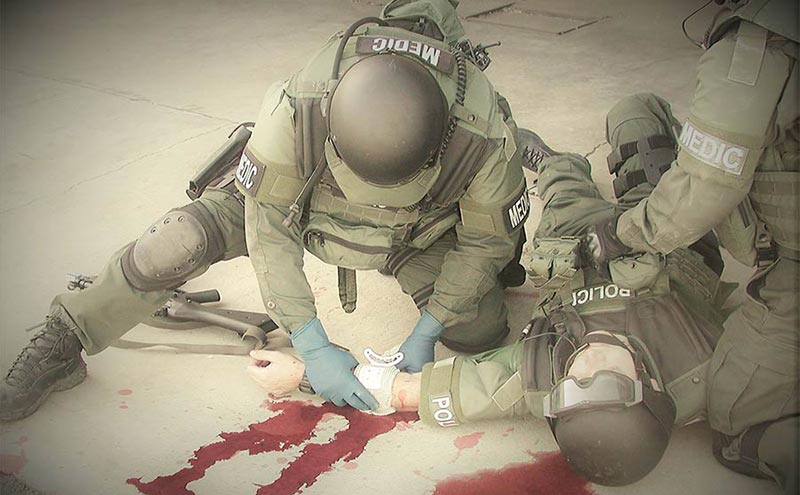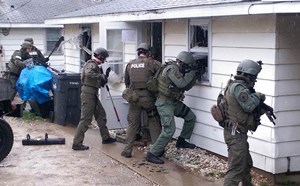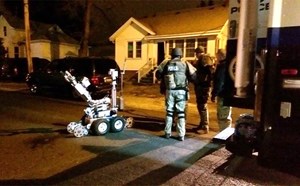
What are operational missions actually like for physicians?
There are several ways in which physicians can participate in supporting law enforcement (LE) and tactical operations. This can range from providing medical oversight and training of paramedics/EMTs and other TMPs, to actually deploying in close-up hands-on medical support in the inner perimeter.
For those physicians who routinely deploy along with the SWAT team in the hot zone, they usually have completed a full LE academy and SWAT courses and are armed and accompany the entry team. An intermediate role for physicians is to be a sworn, armed LE officer or deputy who is issued ballistic helmet and vests and has similar uniforms and deploys with the SWAT team (perhaps along with EMTs / paramedics /nurse TMPs). This intermediate-level physician may move forward with the tactical team to a nearby but relatively safe location behind hardcover within a 30 second response time of tactical officers. For normal-sized houses, the physician and other TMPs may remain outside behind hardcover while the entry teams do their work and enter the small structure. For larger buildings with multiple floors, then these intermediate-located TMPs may actually deploy inside during entry, moving room to room as part of a rescue team and move through the building with SWAT officers who clear threats and TMPs primarily will render tactical emergency medical care. The third type of physician support is a more remote and less integrated approach and may be done outside of the outer perimeter, where the physician is neither armed nor sworn LE officers. In this role, the physician’s primary role is medical support providing advice, preventive care, and if an officer is injured then the goal is to have fellow tactical officers extract the injured casualty out of the inner perimeter to the medical team located near the command post or tactical operations center (TOC).
Note: there is not a standardized approach in tactical medicine, and further studies and research are needed to clarify the risk to reward ratio, and which deployment model is most ideal.
The following is a description of four types of tactical team deployments and what commonly occurs, and how the tactical physician may interact with the incident. These include high-risk arrest/search warrant service, hostage-barricade deployment, high threat executive protection/escort missions, and large crowd tactical team support (conventions, etc). The following is a brief review. There are many other unique and challenging medical considerations, tactics, and techniques that are needed but cannot be listed in the space allowed, which must be learned by basic and advanced tactical medical training, and routine training with tactical teams.
High-risk arrest/search warrant
Tactical team leaders are contacted by LE leaders after following agency matrix protocols to determine a need to serve a warrant for either seizure of evidence (drug sales, or other illegal activity) or arrest of a suspected felon (criminal). The LE agency may use a ‘threat matrix’ (numerical way to calculate if a SWAT team is indicated or not), and the Police Chief or Sheriff will give their permission to utilize the tactical team. A judge signs an arrest or search warrant, and then details are planned by leaders. For activation of the tactical team, a group text may be sent to the SWAT and TEMS unit personnel to meet at a designated location and time. The tactical physician must keep this information confidential in order to maintain secrecy of the mission and maximize mission success. TEMS leaders should meet with tactical leaders to help plan out a medical response plan, and where and when EMS transportation assets (ambulances and helicopters) may be pre-positioned and used, and other TEMS considerations. The tactical and TEMS team will meet at the designated time, and a briefing of the mission will occur, which takes approximately 30 to 45 minutes. At this briefing, all LE and TEMS personnel who will participate in the mission should be present and be fully informed of all aspects of the search/arrest warrant service. An MTA (medical threat assessment) is a way to help identify threats and unique challenges to the tactical and TEMS unit, and special circumstances may result in a change of tactics for the teams involved. (i.e. if the suspect has severe asthma, there may be no predetermined use of ‘gas’ (CS/tear gas/pepper spray canisters).
Following the briefing, tactical and TEMS personnel will go to their personal vehicles or lockers and don their equipment and weapons and practice getting out of vehicles and practice deployment for the mission. Included will also be others who are participating, such as negotiations officers, bomb-squad members, K-9 officers and their dogs, narcotics teams, and other state or federal LE officers (FBI, US Marshalls, DEA, State Police, undercover officers, INS, others). During some counter-drug search and arrest warrant missions, tactical physicians (JW) have been involved with over 135 federal, state, and local LE officers involved, simultaneously entering 5 houses and taking down 2 vehicles at the same time. Other missions may involve a normal-sized tactical team of 18 to 20 officers and 2 TMPs who enter a small house with a goal of arresting a known suspect.
After rehearsing and fully gearing up, the tactical and TEMS personnel will double-check communications equipment, load up into vehicles (Bearcat armored vehicle, police vans, undercover vehicles, boats, helicopters, or other vehicles), and travel to the site of the mission. Entry will be either slow and stealthy, or it may be a rapid ‘no-knock’ warrant with a dynamic approach and entry. Pre-mission intelligence will usually help dictate whether a battering ram or welding torch or saw or other method is needed to defeat the door and gain entry. Explosive entry techniques may be necessary, and all team members should be aware of the location and precautions necessary.
Once the entry team (or two or three) has gained entry and performed a thoroughly room-by-room clearing of all levels of the building or site, then it will be determined ‘clear’, and then detectives and other personnel from the investigations teams will be authorized to enter and search for evidence. Any suspects who were inside will be neutralized, secured, handcuffed, and searched thorough, and arrested if indicated. If there are any injuries then the tactical physician and/or other TMPs will be asked to evaluate and stabilize the suspect, bystanders, or LE officer casualties. Pre-incarceration screening exams may be performed, and recommendations given to LE command for transport of suspects to the jail, or to a hospital, depending upon injury severity.
All tactical and TEMS personnel should be accounted for at completion of the mission, and then an orderly withdrawal from the scene should occur. A debriefing afterwards should be attended by all involved, and the positive and negative aspects of the mission should be noted and learned from. If any medical care is needed, this may be discussed as appropriate, keeping in mind the HIPAA regulations. TMPs should communicate amongst themselves the dynamic changes occurring before, during, and after the mission, and future performance will be enhanced by discussing lessons learned and replacing gear used, and look for better ways to do it next time.
Hostage-Barricade Deployment Missions
This type of mission is among the most complex and difficult SWAT deployment. Due to the sudden and unplanned nature of this event, the tactical and TEMS personnel will often be notified by text and/or phone call to report directly to the incident command site or TOC (tactical operations center) which is located 1 or 2 city blocks safely distant from the hostage-barricade site.
Tactical physicians should arrive and immediately contact team leaders and must strive to become geared-up quickly and properly for what may end up being a very long multi-day deployment, or it could potentially end violently and quickly without any warning. Therefore, an “immediate reaction team” will be formed rapidly, and this will consist of several TMPs as well as 4 or 5 armed SWAT officers who rapidly assemble their gear and deploy to a nearby location close to the presumed hostage site. If there are any sudden signs of the hostage being harmed (screams, or gunshots, etc.) then this team will likely deploy and gain entry and try to rescue the hostage before further harm occurs.
A key asset is the hostage negotiations team, whose members will try to establish communication with the hostage-takers and try to resolve the crisis without any unnecessary injuries or deaths. Tactical physicians and other TMPs can assist by working with the tactical team and detectives to help gather medical intelligence about the suspects and hostages involved, and create an MTA (medical threat assessment), and modify the MTA as conditions and the dynamics of the crisis change. Sometimes this information can be utilized by the negotiations teams to end the crisis peacefully. There are also many other variables that are beyond the space limitations of this section.
With good fortune, the hostage can be safely rescued, and no injuries or deaths occur. However, some of these situations do end with violence, and tactical medical skills may be needed.
Following the crisis ending, at some point in time, a debriefing should occur, and this may be a day or two later, depending upon the degree of fatigue and stress that the tactical and TEMS personnel had to deal with. This completes the discussion of hostage-barricade deployments.
High threat Executive Protection/Escort Mission
Whether supporting a SWAT/tactical team in a small, medium, or large-sized community, if there are any visits by “VIPs” (very important persons) or executives such as the President of the United States (POTUS), then it is very likely that the community’s law enforcement agencies will be involved in helping to optimize transportation and enhance security of the executive. This will include escort missions (motorcade) and on-site security during the visit.
Executive protection is a complex topic, and multiple large textbooks have been written on the subject. Involvement of the community’s tactical physician (and other local TMPs) will primarily consist of ‘being there for the local team’, and thus support of the local tactical team(s) will be the primary mission. When asked to assist the U.S. Secret Service, the local SWAT teams are often involved, along with a large percentage of the local police and county deputies and state police. For a majority of circumstances, the U.S. Secret Service personnel are very well trained and equipped to handle most threats. The exception is this, if there would happen to be a large-scale attack on the POTUS, then the additional firepower of the local SWAT team would be a benefit. Because the POTUS travels with an advanced medical team and their own ambulance, TEMS personnel would very rarely be needed to provide medical care for the President and Secret Service personnel.
In general, deployment for executive protection includes clarifying the leadership decisions, notification and briefing, and possible training prior to the mission, assembling and gearing up at the location, and then active deployment for the executive protection ‘detail’ or motorcade. If the VIP is accompanied by family members, then these persons should also be included in the formation of the MTA (medical threat assessment), along with all involved executive protection team members.
Hopefully, the travel and on-site location protective detail proceeds without any major incidents or hiccups, and all will remain healthy. If illness or injuries occur, then the TEMs element will be responsible for ensuring appropriate medical care is given. Medical supplies and transportation assets will vary, depending upon the geography and conditions. In Third World developing countries, there may be very limited assets and medical care facilities may be relatively primitive. Adequate preplanning and realistic preparation will go a long way towards successful mission completion.
Large Crowd Gathering Tactical Medical Support
The concept of providing medical care for a large crowd event is complex and beyond the scope of this section. Limited discussion is included here on the sub-topic of providing tactical medical support for the tactical team and executive protection personnel. The provision of medical care for citizens attending a large event is another topic by itself, and ACEP has a Section of members interested in this topic, and has position papers and many references available.
A tactical physician may be involved in a very large crowd gathering such as political event (Republican or Democratic National Conference), concert, special event, or perhaps at a location where a large number of people are demonstrating or rioting. Special considerations need to be given at these types of events, and in the near future, one of our physicians will describe a deployment at the 2020 Republican National Convention. (RNC). "More to Come"



